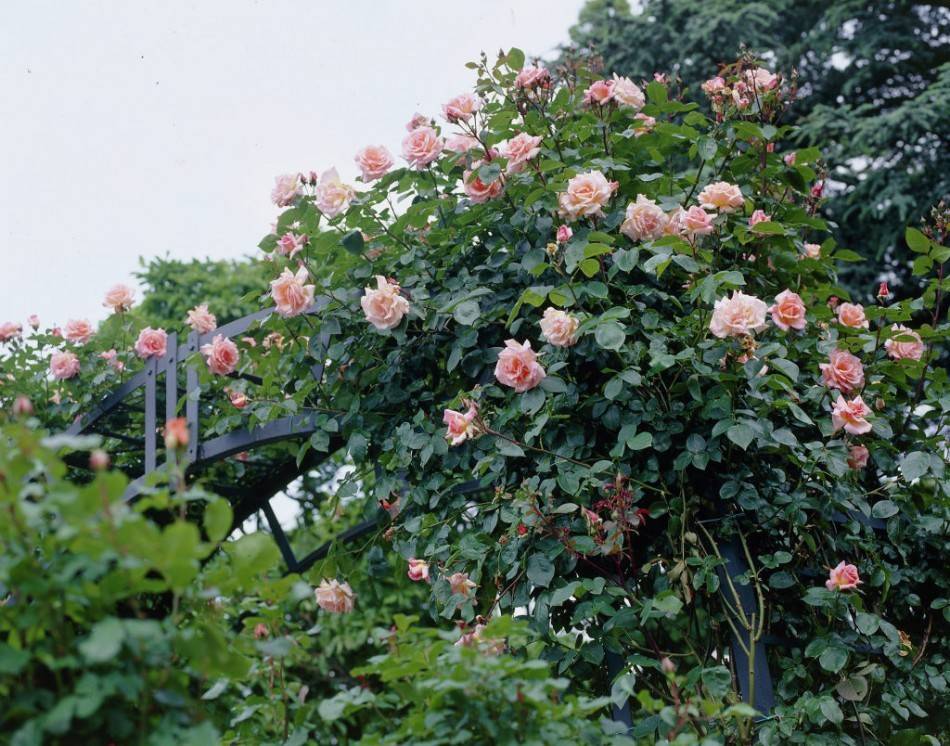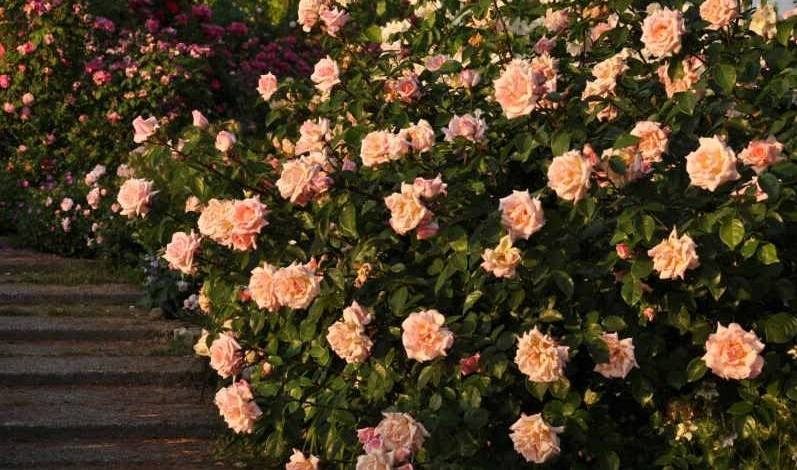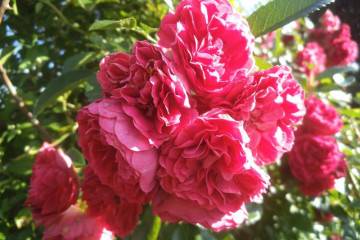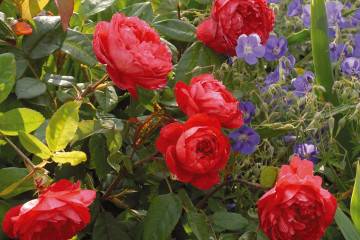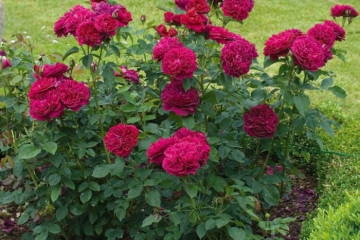Rose Compassion - variety description
Content:
The Compassion park climbing rose was bred several decades ago. The flower quickly won the love of gardeners all over the world.
Rosa Compeshne: description and characteristics
The Compassion variety (translated from English - "compassion") was bred by the specialists of the Harkness company and presented at one of the rose exhibitions in 1973.
Strong lashes of the plant stretch to a length of up to 3 m, they are covered with dark green leaves and large sharp thorns. The flowers are large, up to 15 cm in diameter, consist of 45 petals, collected in inflorescences up to 5 pcs. The color is heterogeneous: from bright orange to pale pink. The aroma is bright, sweetish.
The Compound variety has a number of advantages. Among them:
- endurance and resistance to various diseases (confirmed by the assignment of the ADR category);
- frost tolerance up to -34 ° С;
- re-flowering;
- rapid growth of shoots.
The disadvantages include a certain exactingness - for normal development and flowering, the plant needs a clear schedule of watering and fertilization. It is also worth considering the need for regular forming trimming, hampered by the sharpness of the thorns.
In addition, the flower is used as a hedge. It is recommended to plant ground cover and undersized ornamental plants in the vicinity.
How to properly plant in open ground and grow a flower
The development of the Compassion rose bush depends on the correct planting. Compliance with all the nuances will allow you to get a healthy and luxuriantly flowering plant.
This variety is planted in the ground only in the form of rooted cuttings. The seedlings obtained by sowing seeds lose their varietal characteristics. It is recommended to buy seedlings only in proven nurseries or stores.
Seat selection
The landing site should be on a hill and well lit. Nearby, at a distance of at least 50 cm, there must be a stable support structure with a height of at least 2 m, along which pink whips will curl.
How to prepare the soil and flower for planting
The plant needs a loose air and moisture permeable nutrient soil. Therefore, the soil at the landing site is dug up in advance, introducing river sand into it and enriching fertilizing from organics and minerals.
Seedlings with a closed root system do not require special preparation. Specimens with open roots are recommended to be kept in water for 6-12 hours before planting.
Planting procedure step by step
Planting a plant in the ground should take place in a specific sequence. The procedure consists of the following steps:
- Dig a landing hole with a depth of 2 shovel bayonets. If there are several seedlings, then a distance of at least 1 m should be left between them.
- A 10 cm drainage layer is poured into the pit and covered with earth.
- The plant is placed in a hole, the roots are carefully straightened.
- The roots are covered with earth, preventing airing.
- The plant is watered abundantly, and mulch is poured around.
Plant care
Climbing rose Compeshne is quite whimsical, so you should pay enough attention to carrying out care procedures. However, the care steps are standard and do not take too long.
Watering rules and humidity
Water the London Beauty 1-2 times a week, depending on the weather. For this, settled water is used at the rate of 1 bucket per bush. If possible, it is recommended to irrigate by sprinkling in the morning. Towards the end of the season, watering is reduced.
Top dressing and soil quality
A profusely flowering plant expends a lot of energy and nutrients. Therefore, throughout the season, it is fed every 2-3 weeks. In spring, preference is given to complex compositions containing nitrogen, and with the beginning of budding they switch to phosphorus-potassium fertilizers.
Pruning and replanting
In the first year of a bush's life, pruning is carried out several times during the season. In this case, it is imperative that all shoots directed inward are cut off in order to avoid thickening of the crown. When pruning in autumn, old lignified shoots are removed.
Features of wintering a flower
Climbing varieties of roses require mandatory shelter. The lashes are carefully removed from the support, tied together and tilted to the ground, covered with a non-woven cloth. Some gardeners prefer to wrap the plant directly on the support.
Blooming rose
Compensation blooms several times during the season. The bushes at this time are evenly covered with lush inflorescences of peach-pink shades.
A period of activity and rest
The first wave of flowering occurs in early June and lasts about 3 weeks, the flowers bloom gradually. After a short, almost imperceptible, rest, new buds appear. With proper care, the Compound Climbing Rose will continue to bloom until the fall frost.
Care during and after flowering
To prolong flowering, withered flowers should be removed from the bush. At the end of the season, it is recommended to cut off all unopened buds so that the plant has time to prepare for winter.
What to do if it does not bloom
The lack of flowering may indicate the need for fertilizing with a predominance of phosphorus and potassium.
Flower propagation
Compassion seeds are not propagated. You can get planting material by dividing the bush, cutting or rooting cuttings. The last method is the simplest when it comes to climbing roses.
The optimal time for laying cuttings in the ground is May. During the season, they manage to put down roots and winter well.
For rooting, choose strong shoots and put them in a groove 10 cm deep next to the bush, so that 1-2 buds are at the bottom and the same amount at the top. The lash is pinned, sprinkled with earth and periodically moistened during the summer.With the onset of spring, young plants are separated from the mother bush and transplanted.
Diseases, pests and ways to control them
Of the insect pests for Kompeshn, the most dangerous are aphids and spider mites. Aktara, karbofos and neoron help in the fight against them.
Despite its resistance to many diseases, if the rules of care are violated, the plant may undergo the development of powdery mildew and gray rot. For the purpose of prevention, it is recommended to spray the bush with Bordeaux liquid in the spring.
Although the Compassion variety requires certain growing conditions, following these rules, you can get a beautiful healthy climbing rose bush. With a little imagination, the gardener will be able to create a wonderful flowering gallery or terrace on the site.
